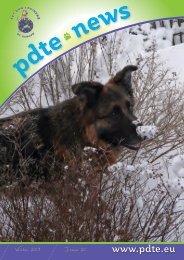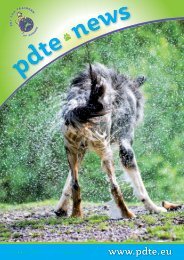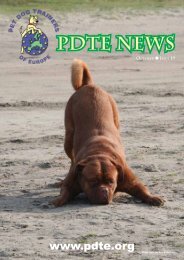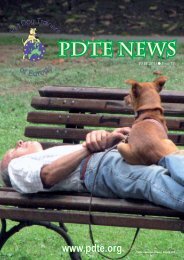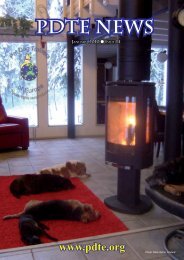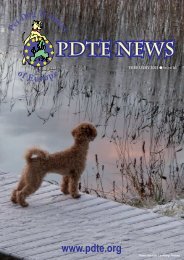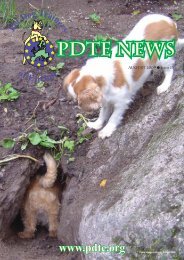PDTE 2016 July Newsletter
Create successful ePaper yourself
Turn your PDF publications into a flip-book with our unique Google optimized e-Paper software.
Sleep is a complex process of active<br />
internal restoration, recuperation and<br />
reconsolidation that is essential to our<br />
health and well-being. It is the same<br />
for our dogs.<br />
Sleep is essential to our well being.<br />
When we do not sleep we do not<br />
function as well, we feel tired and<br />
irritable, we make mistakes and if taken<br />
to extremes we die. It is the same with<br />
our dogs and their sleep patterns are<br />
similar to ours.<br />
The slow wave phase is followed by the rapid eye movement phase (REM).<br />
Interestingly, there is more electrical activity in the brain when in REM sleep than<br />
when awake. This is true of dogs and humans. The dog may seem more agitated<br />
during this type of sleep. You may notice his eyes rolling and the dog may even<br />
whine, bark or move his limbs. The increased electrical activity in the brain is<br />
attributed to dreams, according to one theory 1 . Puppies will spend more time in<br />
the REM phase. During REM sleep, there is also increased activity of a specific<br />
part of the brain, which has an effect on GABA 2 . The increased electrical activity<br />
also results in paralysis of the core muscles so they cannot get up but will twitch,<br />
wag their tails, whimper etc... this is why dogs must be able to lie flat out. A short<br />
video of a dog in REM sleep can be seen on the <strong>PDTE</strong> Belgium page.<br />
In depth:<br />
Understanding sleep<br />
Sleep is a complex process of active internal restoration, recuperation and reconsolidation that is<br />
essential to our health and well-being. Marina Gates Flemming from Belgium lays out all the details<br />
Photo Credit: Kirsten Merkel, Netherlands<br />
Slow Wave Sleep (Non REM Sleep)<br />
takes up about 70% of our dog’s<br />
sleeping time. This is the time the brain<br />
sleeps. It has 3 stages:<br />
Stage 1: the stage between<br />
wakefulness and sleep. It is difficult<br />
to pinpoint the actual point of falling<br />
asleep as brain wave activity gradually<br />
slows down with breathing becoming<br />
more regular and the heart rate<br />
slowing down.<br />
Dogs need more sleep than<br />
we do. Adult dogs need<br />
about sixteen hours of<br />
sleep a day. Puppies need about<br />
twenty hours of sleep each day.<br />
Safety is essential for dogs to sleep<br />
well (beware of slippery floors) and<br />
we should not disturb our sleeping<br />
dogs.<br />
Dogs are polyphasic sleepers; they<br />
will choose somewhere to sleep for a<br />
while before getting up and moving<br />
somewhere else. This is normal and<br />
instinctive behaviour. Dogs are also<br />
social animals. They normally like to<br />
sleep with company, day and night;<br />
In multi-dog households though,<br />
they may occasionally need to have<br />
the opportunity to sleep alone and<br />
in peace, away from others. Sleep is<br />
a time for them to get some peace<br />
and quiet - our lives can sometimes<br />
be too noisy and active for them.<br />
Dogs should have lots of choices when<br />
it comes to sleeping surfaces. Sofas,<br />
beanbags, baskets, cushions, fluffy<br />
rugs, sheepskins, raised beds, blankets<br />
etc make for wonderful sleeping<br />
surfaces. The sleeping surfaces should<br />
vary in type and size. Provide them at<br />
different locations in the house (and in<br />
the garden when the weather is right).<br />
The sleeping surfaces should have<br />
enough space to lie flat, or curled up<br />
or on top or under things<br />
I would now like to go into a little<br />
more detail on the role sleep plays<br />
in helping our body and brain to<br />
rebalance. Indeed, we might be<br />
tempted to think that sleep is a<br />
passive state of unconsciousness,<br />
this is however far from the truth.<br />
Photo Credit: Marina Gates Flemming, Belgium<br />
Stage 2: the first real stage of<br />
sleep during which muscle activity<br />
decreases further and conscious<br />
awareness of the outside world begins<br />
to fade completely. Brain waves are<br />
mainly in the theta wave range (as<br />
in stage 1 sleep), but in addition the<br />
dog experiences short bursts of brain<br />
activity (spindles) and K-complexes.<br />
Together, these help to protect sleep<br />
by suppressing response to outside<br />
stimuli, as well as aiding in sleepbased<br />
memory consolidation and<br />
information processing.<br />
Stage 3: is also known as deep, delta<br />
or slow-wave sleep (SWS). During<br />
this period the dog will be even less<br />
responsive to the outside world and<br />
pretty much unaware of any sounds or<br />
other stimuli. Both brain activity and<br />
physical indicators such as breathing<br />
rate, heart rate and blood pressure are<br />
all at their lowest levels. Information<br />
processing and memory consolidation<br />
continues to occur during this period.<br />
Photo Credit: Winkie Spiers, UK<br />
SWS and REM sleep promote different types of learning and REM sleep<br />
appears to promote brain development. Sleep is important for the following:<br />
• Recreating homeostasis<br />
• Rebalancing serotonin levels<br />
• Regulating brain electricity<br />
• Consolidating memory<br />
• Reducing cortisol levels<br />
• Boosting the immune system<br />
• Enhancing tissue repair in the brain (and the body)<br />
• Safe experiencing of potential outcomes prepare the<br />
brain for future possibilities<br />
So let’s make sure that both we and our dogs get the safe, good quality and<br />
comfortable sleep we need on a regular basis.<br />
1<br />
Studies have indicated that dogs have the same blood flow to the visual areas of their<br />
brain that we do, so it is very likely that they are seeing images.<br />
2<br />
GABA is the most inhibitory neurotransmitter in the brain and it appears to have a<br />
widespread distribution in both the brain and spinal cord. Its natural function is to reduce<br />
the activity of the neurons. Some researchers believe that one of the purposes that GABA<br />
serves is to control the fear or anxiety experienced when neurons are overexcited<br />
12<br />
<strong>PDTE</strong> <strong>Newsletter</strong> <strong>PDTE</strong> <strong>Newsletter</strong> 13










